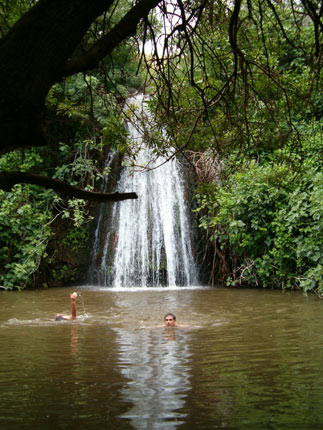Located on the edge of a desert belt, Israel has always suffered a scarcity of water. Archeological discoveries in the Negev and other parts of the country reveal that local inhabitants thousands of years ago were already concerned with water conservation, as evidenced by a variety of systems, designed both to collect and store rainwater and transfer it from one place to another.
The total annual renewable water resources amount to some 60 billion cubic feet (1.7 billion cu.m.), of which about 65 percent is used for irrigation and the balance for urban and industrial purposes. The country's water sources consist of the Jordan River, Lake Kinneret, and a few small river systems. Natural springs and underground water tables, tapped in controlled quantities to prevent depletion and salination, are also utilized.
As maximum use has been made of all freshwater sources, ways are being developed to exploit marginal water resources through the recycling of waste brackish water, and desalination of seawater.
To overcome regional imbalances in water availability, most of Israel's freshwater sources are joined in an integrated grid. Its central artery, the National Water Carrier, completed in 1964, brings water from the north and central regions, through a network of giant pipes, aqueducts, open canals, reservoirs, tunnels, dams and pumping stations, to the semi-arid south.
True to Israeli style, innovation was born of necessity, and Israeli researchers and engineers pioneered ground-breaking water technologies, such as drip irrigation, water recycling and desalination, positioning Israel as a global leader in the field. Today, more than 80 percent of Israeli household waste water is recycled for agricultural use.
Section of the ancient Roman aqueduct to Caesarea
(Photo: M. Horneman)
Given a long summer season with virtually no rain, water is scarce in the region. True to Israeli style, innovation was born of necessity, and Israeli researchers and engineers pioneered ground-breaking water technologies, such as drip irrigation, water recycling and desalination, positioning Israel as a global leader in the field. Today, more than 80 percent of Israeli household waste water is recycled for agricultural use.

Waterfall in northern Israel (Photo: S. Lederhendler)
Israel's Water Industry - A History of Turning Desert into Oasis
Since its creation in 1948, Israel has placed great emphasis on maximizing its water supply, famously turning much of its arid land into fertile agricultural soil. Indeed, David Ben Gurion, Israel’s founding father, declared the goal of “making the desert bloom” as one of the central themes of the new nation, believing it could be one of its main contributions to the world. Thus, water technologies have been a national priority in Israel since day one. This emphasis has proven itself in one of the world’s most efficient and innovative water systems.
The Israeli water industry is today recognized as a global leader in the water arena thanks to breakthrough technological innovations in areas such as desalination, drip irrigation and water security.
-The Hadera seawater reverse osmosis (SWRO) desalination plant in Israel is one of the largest of its kind in the world.
-Israel reclaims almost 75% of its reused effluents in agriculture.
-Israel’s total water consumption has remained nearly the same since 1964, in spite of a growing population and agriculture. This feat has been enabled through improved efficiency and technological innovation.
-By 2013, desalination plants in Israel would supply more than 500 million m of water per year, supplying 35% of the country’s fresh water needs. |